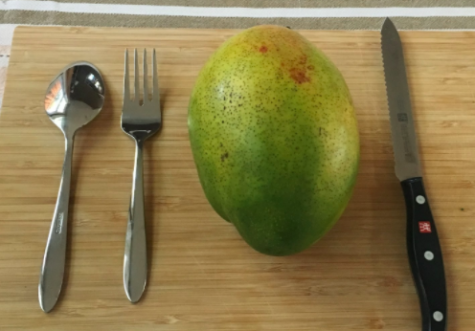Memoir Monday: Dual Mangoes
November 6, 2017
 Arya Maheshwari
Arya Maheshwari
The oblong Keitt mango rests against the wooden cutting board, almost calling me to eat it. With forest green splashes towards the bottom, a few reddish-yellow patches at the top and a chartreuse in the middle, the mango seems well ripened. First, indulging my obsessive thirst for symmetry, I spend a good thirty seconds optimizing where to make the initial two cuts to avoid the fibrous middle section of the mango. Once I find satisfactory spots, I carefully cut out the center section to create the two side pieces, feeling the gratifying sensation of the knife moving through the mango’s firm yet tender flesh as it splits apart. Focusing in on the prize fruit in front of me, the chirping of the birds, rustling of tree leaves and other suburban noises around me fade away. I then cut a grid-like pattern into each side, making sure to keep my lines straight and equidistant, as juice begins flowing into the thin cuts. Scooping the chunks out of the skin with a spoon, I toss the pieces into a bowl, stab one with my fork and dive in.
But even as I rejoice in my perfectly immaculate procedure of mango cutting in California, I recall with as much affection eating mangoes in India, a completely disparate experience. As I remember, I am transported back to my grandparents’ house, about four years ago on the fateful morning of where I learned how to eat a special type of mango. On the flat garden roof of the house, I sat across my grandmother adorned in a class Indian garment with horned reading glasses. In my classic American outfit of sweatpants and a t-shirt, I could see northern Bombay, both the skyscrapers and the run-down tenements, with the quintessential car horns noisily firing in the distance.
When my grandmother first showed me the mango, I stifled a laugh: it was hardly a quarter the size of my trusty Keitts, and there was no way I could properly slice or eat it. Seeing the typical skepticism of foreigners, my grandmother smiled knowingly and told me to watch her. Suddenly, she began rapidly rolling the small fruit in her hands, softening it to a mushy consistency. Then, piercing the top with her nails, she effectively made a circular hole in the mango. I cringed on the sideline, wondering what exactly she was doing. She raise the top of the fruit to her mouth and began slurping loudly, and I watched in awe: she was, quite literally, drinking the mango. Amazed, I copied her, trying to soften it properly and prick out the top, but the overflow and sticky mess I created still nettled my need for cleanliness. In a short time, however, I became overwhelmed by the pure bliss as I forgot any previous distresses. For the rest of the trip, it was hard to separate me from any of the other mangoes.
When I left India that year, I lamented the prospect of not being able to enjoy the special type of mango. Now, whenever I eat a Keitt, or any other type of American mango, the memory always comes back to me, and I marvel at the total contrast between my two methods of eating a mango. On the American side, the procedure is perfectly methodical and neat, representative of my classic American demeanor. On the Indian side, the process is delightfully messy, like my more vivacious Indian heritage. And looking back now, I realize that no matter where I am, I’ll always remember the other form of eating a mango, just as I’ll always remember the other half of my cultural identity.


















![“[Building nerf blasters] became this outlet of creativity for me that hasn't been matched by anything else. The process [of] making a build complete to your desire is such a painstakingly difficult process, but I've had to learn from [the skills needed from] soldering to proper painting. There's so many different options for everything, if you think about it, it exists. The best part is [that] if it doesn't exist, you can build it yourself," Ishaan Parate said.](https://harkeraquila.com/wp-content/uploads/2022/08/DSC_8149-900x604.jpg)




![“When I came into high school, I was ready to be a follower. But DECA was a game changer for me. It helped me overcome my fear of public speaking, and it's played such a major role in who I've become today. To be able to successfully lead a chapter of 150 students, an officer team and be one of the upperclassmen I once really admired is something I'm [really] proud of,” Anvitha Tummala ('21) said.](https://harkeraquila.com/wp-content/uploads/2021/07/Screen-Shot-2021-07-25-at-9.50.05-AM-900x594.png)







![“I think getting up in the morning and having a sense of purpose [is exciting]. I think without a certain amount of drive, life is kind of obsolete and mundane, and I think having that every single day is what makes each day unique and kind of makes life exciting,” Neymika Jain (12) said.](https://harkeraquila.com/wp-content/uploads/2017/06/Screen-Shot-2017-06-03-at-4.54.16-PM.png)








![“My slogan is ‘slow feet, don’t eat, and I’m hungry.’ You need to run fast to get where you are–you aren't going to get those championships if you aren't fast,” Angel Cervantes (12) said. “I want to do well in school on my tests and in track and win championships for my team. I live by that, [and] I can do that anywhere: in the classroom or on the field.”](https://harkeraquila.com/wp-content/uploads/2018/06/DSC5146-900x601.jpg)
![“[Volleyball has] taught me how to fall correctly, and another thing it taught is that you don’t have to be the best at something to be good at it. If you just hit the ball in a smart way, then it still scores points and you’re good at it. You could be a background player and still make a much bigger impact on the team than you would think,” Anya Gert (’20) said.](https://harkeraquila.com/wp-content/uploads/2020/06/AnnaGert_JinTuan_HoHPhotoEdited-600x900.jpeg)

![“I'm not nearly there yet, but [my confidence has] definitely been getting better since I was pretty shy and timid coming into Harker my freshman year. I know that there's a lot of people that are really confident in what they do, and I really admire them. Everyone's so driven and that has really pushed me to kind of try to find my own place in high school and be more confident,” Alyssa Huang (’20) said.](https://harkeraquila.com/wp-content/uploads/2020/06/AlyssaHuang_EmilyChen_HoHPhoto-900x749.jpeg)







akshay • Feb 1, 2019 at 9:11 am
i love mangues
Andy Lee • Nov 16, 2017 at 1:57 pm
great stuff!